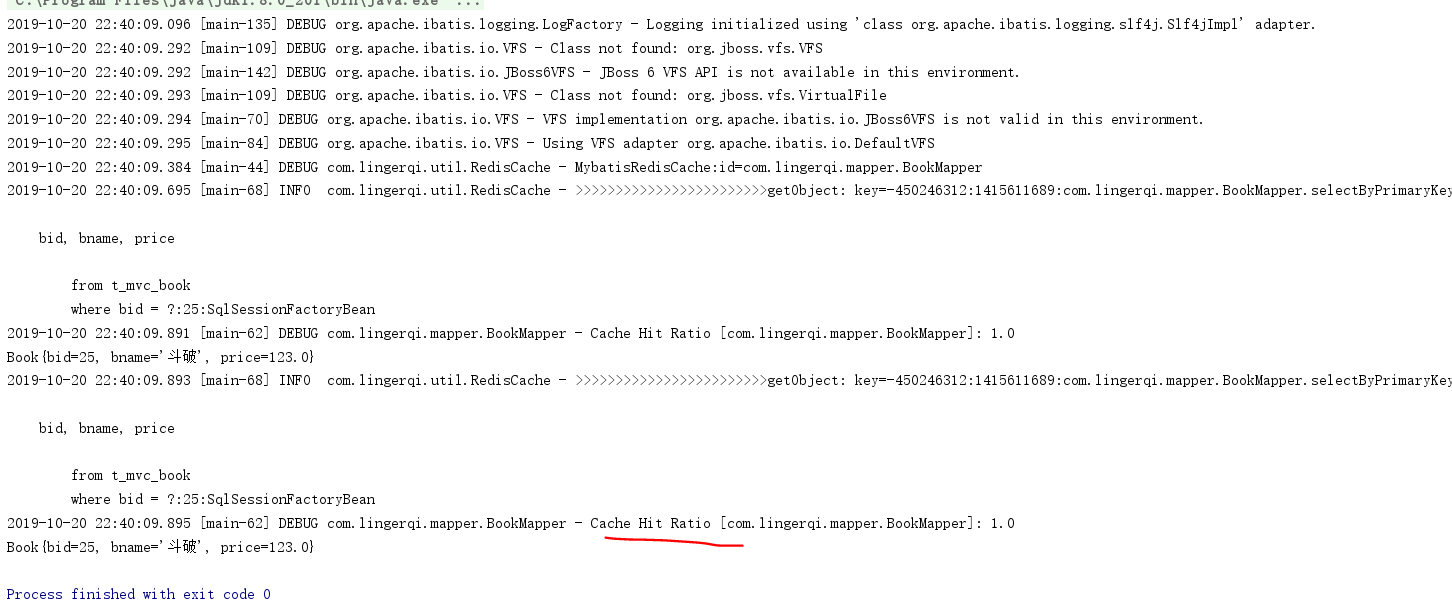Mybatis集成ehcache
1. 为什么需要缓存
拉高程序的性能
2. 什么样的数据需要缓存
很少被修改或根本不改的数据
业务场景比如:耗时较高的统计分析sql、电话账单查询sql等
3. ehcache是什么
Ehcache 是现在最流行的纯Java开源缓存框架,配置简单、结构清晰、功能强大
注1:本章介绍的是2.X版本,3.x的版本和2.x的版本API差异比较大
4. ehcache的特点
4.1 够快
Ehcache的发行有一段时长了,经过几年的努力和不计其数的性能测试,Ehcache终被设计于large, high concurrency systems.
4.2 够简单
开发者提供的接口非常简单明了,从Ehcache的搭建到运用运行仅仅需要的是你宝贵的几分钟。其实很多开发者都不知道自己用在用Ehcache,Ehcache被广泛的运用于其他的开源项目
4.3 够袖珍
关于这点的特性,官方给了一个很可爱的名字small foot print ,一般Ehcache的发布版本不会到2M,V 2.2.3 才 668KB。
4.4 够轻量
核心程序仅仅依赖slf4j这一个包,没有之一!
4.5 好扩展
Ehcache提供了对大数据的内存和硬盘的存储,最近版本允许多实例、保存对象高灵活性、提供LRU、LFU、FIFO淘汰算法,基础属性支持热配置、支持的插件多
4.6 监听器
缓存管理器监听器 (CacheManagerListener)和 缓存监听器(CacheEvenListener),做一些统计或数据一致性广播挺好用的
4.7 分布式缓存
从Ehcache 1.2开始,支持高性能的分布式缓存,兼具灵活性和扩展性
3. ehcache的使用
3.1 导入相关依赖
3.2 核心接口
CacheManager:缓存管理器
Cache:缓存对象,缓存管理器内可以放置若干cache,存放数据的实质,所有cache都实现了Ehcache接口
Element:单条缓存数据的组成单位
4. ssm中整合ehcache
4.1 导入相关依赖
<dependency>
<groupId>org.springframework</groupId>
<artifactId>spring-context-support</artifactId>
<version>${spring.version}</version>
</dependency>
<!--mybatis与ehcache整合-->
<dependency>
<groupId>org.mybatis.caches</groupId>
<artifactId>mybatis-ehcache</artifactId>
<version>1.1.0</version>
</dependency>
<!--ehcache依赖-->
<dependency>
<groupId>net.sf.ehcache</groupId>
<artifactId>ehcache</artifactId>
<version>2.10.0</version>
</dependency>
修改日志配置,因为ehcache使用了Slf4j作为日志输出
日志我们使用slf4j,并用log4j来实现。SLF4J不同于其他日志类库,与其它有很大的不同。
SLF4J(Simple logging Facade for Java)不是一个真正的日志实现,而是一个抽象层( abstraction layer),
它允许你在后台使用任意一个日志类库。
<!-- log4j2日志配置相关依赖 -->
<log4j2.version>2.9.1</log4j2.version>
<log4j2.disruptor.version>3.2.0</log4j2.disruptor.version>
<slf4j.version>1.7.13</slf4j.version>
<!-- log4j2日志相关依赖 -->
<!-- log配置:Log4j2 + Slf4j -->
<!-- slf4j核心包-->
<dependency>
<groupId>org.slf4j</groupId>
<artifactId>slf4j-api</artifactId>
<version>${slf4j.version}</version>
</dependency>
<dependency>
<groupId>org.slf4j</groupId>
<artifactId>jcl-over-slf4j</artifactId>
<version>${slf4j.version}</version>
<scope>runtime</scope>
</dependency>
<!--核心log4j2jar包-->
<dependency>
<groupId>org.apache.logging.log4j</groupId>
<artifactId>log4j-api</artifactId>
<version>${log4j2.version}</version>
</dependency>
<dependency>
<groupId>org.apache.logging.log4j</groupId>
<artifactId>log4j-core</artifactId>
<version>${log4j2.version}</version>
</dependency>
<!--用于与slf4j保持桥接-->
<dependency>
<groupId>org.apache.logging.log4j</groupId>
<artifactId>log4j-slf4j-impl</artifactId>
<version>${log4j2.version}</version>
</dependency>
<!--web工程需要包含log4j-web,非web工程不需要-->
<dependency>
<groupId>org.apache.logging.log4j</groupId>
<artifactId>log4j-web</artifactId>
<version>${log4j2.version}</version>
<scope>runtime</scope>
</dependency>
<!--需要使用log4j2的AsyncLogger需要包含disruptor-->
<dependency>
<groupId>com.lmax</groupId>
<artifactId>disruptor</artifactId>
<version>${log4j2.disruptor.version}</version>
</dependency>
在Resource中添加一个ehcache.xml的配置文件
<?xml version="1.0" encoding="UTF-8"?>
<ehcache xmlns:xsi="http://www.w3.org/2001/XMLSchema-instance"
xsi:noNamespaceSchemaLocation="http://ehcache.org/ehcache.xsd"
updateCheck="false">
<!--磁盘存储:将缓存中暂时不使用的对象,转移到硬盘,类似于Windows系统的虚拟内存-->
<!--path:指定在硬盘上存储对象的路径-->
<!--java.io.tmpdir 是默认的临时文件路径。 可以通过如下方式打印出具体的文件路径 System.out.println(System.getProperty("java.io.tmpdir"));-->
<diskStore path="java.io.tmpdir"/>
<!--defaultCache:默认的管理策略-->
<!--eternal:设定缓存的elements是否永远不过期。如果为true,则缓存的数据始终有效,如果为false那么还要根据timeToIdleSeconds,timeToLiveSeconds判断-->
<!--maxElementsInMemory:在内存中缓存的element的最大数目-->
<!--overflowToDisk:如果内存中数据超过内存限制,是否要缓存到磁盘上-->
<!--diskPersistent:是否在磁盘上持久化。指重启jvm后,数据是否有效。默认为false-->
<!--timeToIdleSeconds:对象空闲时间(单位:秒),指对象在多长时间没有被访问就会失效。只对eternal为false的有效。默认值0,表示一直可以访问-->
<!--timeToLiveSeconds:对象存活时间(单位:秒),指对象从创建到失效所需要的时间。只对eternal为false的有效。默认值0,表示一直可以访问-->
<!--memoryStoreEvictionPolicy:缓存的3 种清空策略-->
<!--FIFO:first in first out (先进先出)-->
<!--LFU:Less Frequently Used (最少使用).意思是一直以来最少被使用的。缓存的元素有一个hit 属性,hit 值最小的将会被清出缓存-->
<!--LRU:Least Recently Used(最近最少使用). (ehcache 默认值).缓存的元素有一个时间戳,当缓存容量满了,而又需要腾出地方来缓存新的元素的时候,那么现有缓存元素中时间戳离当前时间最远的元素将被清出缓存-->
<defaultCache eternal="false" maxElementsInMemory="1000" overflowToDisk="false" diskPersistent="false"
timeToIdleSeconds="0" timeToLiveSeconds="600" memoryStoreEvictionPolicy="LRU"/>
<!--name: Cache的名称,必须是唯一的(ehcache会把这个cache放到HashMap里)-->
<!--<cache name="stuCache" eternal="false" maxElementsInMemory="100"-->
<!--overflowToDisk="false" diskPersistent="false" timeToIdleSeconds="0"-->
<!--timeToLiveSeconds="300" memoryStoreEvictionPolicy="LRU"/>-->
</ehcache>
在applicationContext.xml中加入chache配置
<?xml version="1.0" encoding="UTF-8"?>
<beans xmlns="http://www.springframework.org/schema/beans"
xmlns:xsi="http://www.w3.org/2001/XMLSchema-instance"
xsi:schemaLocation="http://www.springframework.org/schema/beans http://www.springframework.org/schema/beans/spring-beans.xsd">
<!-- 使用ehcache缓存 -->
<bean id="cacheManagerFactory" class="org.springframework.cache.ehcache.EhCacheManagerFactoryBean">
<property name="configLocation" value="classpath:ehcache.xml"/>
<property name="shared" value="true"></property>
</bean>
<!-- 默认是cacheManager -->
<bean id="cacheManager" class="org.springframework.cache.ehcache.EhCacheCacheManager">
<property name="cacheManager" ref="cacheManagerFactory"/>
</bean>
</beans>
mybaits的二级缓存是mapper范围级别,除了在SqlMapConfig.xml设置二级缓存的总开关,还要在具体的mapper.xml中开启二级缓存
开启mybatis的二级缓存
applicationContext-mybatis.xml中添加
<!--设置mybaits对缓存的支持-->
<property name="configurationProperties">
<props>
<!-- 全局映射器启用缓存 *主要将此属性设置完成即可-->
<prop key="cacheEnabled">true</prop>
<!-- 查询时,关闭关联对象即时加载以提高性能 -->
<prop key="lazyLoadingEnabled">false</prop>
<!-- 设置关联对象加载的形态,此处为按需加载字段(加载字段由SQL指 定),不会加载关联表的所有字段,以提高性能 -->
<prop key="aggressiveLazyLoading">true</prop>
</props>
</property>
在XxxMapper.xml中配置cache
<!-- 以下两个<cache>标签二选一,第一个可以输出日志,第二个不输出日志 -->
<!--<cache type="org.mybatis.caches.ehcache.LoggingEhcache" />-->
<!--<cache type="org.mybatis.caches.ehcache.EhcacheCache" />-->
<!--eviction="FIFO" 回收策略为先进先出-->
<!--flushInterval="60000" 自动刷新时间60s-->
<!--size="512" 最多缓存512个引用对象-->
<!--readOnly="true" 只读-->
<cache type="org.mybatis.caches.ehcache.EhcacheCache">
<property name="timeToIdleSeconds" value="3600"/>
<property name="timeToLiveSeconds" value="3600"/>
<property name="maxEntriesLocalHeap" value="1000"/>
<property name="maxEntriesLocalDisk" value="10000000"/>
<property name="memoryStoreEvictionPolicy" value="LRU"/>
</cache>
可以通过select标签的useCache属性打开或关闭二级缓存
<select id="selectByPrimaryKey" resultMap="BaseResultMap" parameterType="java.lang.Long" useCache="false"></select>
注意:
1、mybatis默认使用的二级缓存框架就是ehcache(org.mybatis.caches.ehcache.EhcacheCache),无缝结合
2、Mybatis缓存开关一旦开启,可缓存单条记录,也可缓存多条,hibernate不能缓存多条。
3、Mapper接口上的所有方法上另外提供关闭缓存的属性
使用缓存截图:

Mybatis集成redis
1. redis常用类
1.1 Jedis
jedis就是集成了redis的一些命令操作,封装了redis的java客户端
1.2 JedisPoolConfig
Redis连接池
1.3 ShardedJedis
基于一致性哈希算法实现的分布式Redis集群客户端
实现 mybatis 的二级缓存,一般来说有如下两种方式:
1) 采用 mybatis 内置的 cache 机制。
2) 采用三方 cache 框架, 比如ehcache, oscache 等等.
2. 添加jar依赖
<!-- redis与spring的整合依赖 -->
<redis.version>2.9.0</redis.version>
<redis.spring.version>1.7.1.RELEASE</redis.spring.version>
<dependency>
<groupId>redis.clients</groupId>
<artifactId>jedis</artifactId>
<version>${redis.version}</version>
</dependency>
<dependency>
<groupId>org.springframework.data</groupId>
<artifactId>spring-data-redis</artifactId>
<version>${redis.spring.version}</version>
</dependency>
注:
版本冲突问题:
1. ClassNotFoundException : redis/client/util/geoUtils 说这个类找不到。
2. org.springframework.beans.factory.BeanCreationException: Error creating bean with name 'redisTemplate' defined in class path resource [applicationContext.xml]
说创建 redisTemplate bean 对象时失败了。
redis.client 2.9.0 ---- spring-data-redis 1.7.1.RELEASE
redis.client 2.9.0 ---- spring-data-redis 1.7.2.RELEASE 这两个是可以使用的
log4j2配置
<!--核心log4j2jar包-->
<!-- log4j2日志相关依赖 -->
<!-- log配置:Log4j2 + Slf4j -->
<!-- slf4j核心包-->
<dependency>
<groupId>org.slf4j</groupId>
<artifactId>slf4j-api</artifactId>
<version>${slf4j.version}</version>
</dependency>
<dependency>
<groupId>org.slf4j</groupId>
<artifactId>jcl-over-slf4j</artifactId>
<version>${slf4j.version}</version>
<scope>runtime</scope>
</dependency>
jackson
<!-- jackson -->
<jackson.version>2.9.3</jackson.version>
<!-- jackson -->
<dependency>
<groupId>com.fasterxml.jackson.core</groupId>
<artifactId>jackson-databind</artifactId>
<version>${jackson.version}</version>
</dependency>
<dependency>
<groupId>com.fasterxml.jackson.core</groupId>
<artifactId>jackson-core</artifactId>
<version>${jackson.version}</version>
</dependency>
<dependency>
<groupId>com.fasterxml.jackson.core</groupId>
<artifactId>jackson-annotations</artifactId>
<version>${jackson.version}</version>
</dependency>
spring + redis 集成实现缓存功能(与mybatis无关)
添加两个redis的配置文件,并将redis.properties和applicationContext-redis.xml配置到applicationContext.xml文件中
redis.properties
applicationContext-redis.xml
注:
spring中引入第二个属性文件会出现“找不到某个配置项”错误,这是因为spring只允许有一个<context:property-placeholder/>
<!--引入一个属性文件的写法-->
<context:property-placeholder ignore-unresolvable="true" location="classpath:jdbc.properties" />
<!--引入两个或多个属性文件的写法-->
<context:property-placeholder ignore-unresolvable="true" location="classpath:jdbc.properties,classpath:redis.properties" />
通过import标签将applicationContext-redis.xml导入到applicationContext.xml文件中
<!--导入redis配置-->
<import resource="applicationContext-redis.xml"/>
redis.properties
redis.hostName=192.168.136.128 redis.port=6379 redis.password=123456 redis.timeout=10000 redis.maxIdle=300 redis.maxTotal=1000 redis.maxWaitMillis=1000 redis.minEvictableIdleTimeMillis=300000 redis.numTestsPerEvictionRun=1024 redis.timeBetweenEvictionRunsMillis=30000 redis.testOnBorrow=true redis.testWhileIdle=true
applicationContext-redis.xml
<?xml version="1.0" encoding="UTF-8"?>
<beans xmlns="http://www.springframework.org/schema/beans"
xmlns:xsi="http://www.w3.org/2001/XMLSchema-instance"
xmlns:context="http://www.springframework.org/schema/context"
xsi:schemaLocation="http://www.springframework.org/schema/beans http://www.springframework.org/schema/beans/spring-beans.xsd http://www.springframework.org/schema/context http://www.springframework.org/schema/context/spring-context.xsd">
<context:property-placeholder location="classpath:jdbc.properties,classpath:redis.properties"/>
<import resource="applicationContext-redis.xml"></import>
<import resource="applicationContext-mybatis.xml"></import>
</beans>
将redis缓存引入到mybatis中
创建mybatis的自定义缓存类“RedisCache”,必须实现org.apache.ibatis.cache.Cache接口
RedisCache.java
package com.lingerqi.util;
import org.apache.ibatis.cache.Cache;
import org.slf4j.Logger;
import org.slf4j.LoggerFactory;
import org.springframework.beans.factory.annotation.Autowired;
import org.springframework.dao.DataAccessException;
import org.springframework.data.redis.connection.RedisConnection;
import org.springframework.data.redis.core.RedisCallback;
import org.springframework.data.redis.core.RedisTemplate;
import org.springframework.stereotype.Component;
import java.util.concurrent.TimeUnit;
import java.util.concurrent.locks.ReadWriteLock;
import java.util.concurrent.locks.ReentrantReadWriteLock;
public class RedisCache implements Cache //实现类
{
private static final Logger logger = LoggerFactory.getLogger(RedisCache.class);
private static RedisTemplate<String, Object> redisTemplate;
private final String id;
/**
* The {@code ReadWriteLock}.
*/
private final ReadWriteLock readWriteLock = new ReentrantReadWriteLock();
@Override
public ReadWriteLock getReadWriteLock() {
return this.readWriteLock;
}
public static void setRedisTemplate(RedisTemplate redisTemplate) {
RedisCache.redisTemplate = redisTemplate;
}
public RedisCache(final String id) {
if (id == null) {
throw new IllegalArgumentException("Cache instances require an ID");
}
logger.debug("MybatisRedisCache:id=" + id);
this.id = id;
}
@Override
public String getId() {
return this.id;
}
@Override
public void putObject(Object key, Object value) {
try {
logger.info(">>>>>>>>>>>>>>>>>>>>>>>>putObject: key=" + key + ",value=" + value);
if (null != value)
redisTemplate.opsForValue().set(key.toString(), value, 60, TimeUnit.SECONDS);
} catch (Exception e) {
e.printStackTrace();
logger.error("redis保存数据异常!");
}
}
@Override
public Object getObject(Object key) {
try {
logger.info(">>>>>>>>>>>>>>>>>>>>>>>>getObject: key=" + key);
if (null != key)
return redisTemplate.opsForValue().get(key.toString());
} catch (Exception e) {
e.printStackTrace();
logger.error("redis获取数据异常!");
}
return null;
}
@Override
public Object removeObject(Object key) {
try {
if (null != key)
return redisTemplate.expire(key.toString(), 1, TimeUnit.DAYS);
} catch (Exception e) {
e.printStackTrace();
logger.error("redis获取数据异常!");
}
return null;
}
@Override
public void clear() {
Long size = redisTemplate.execute(new RedisCallback<Long>() {
@Override
public Long doInRedis(RedisConnection redisConnection) throws DataAccessException {
Long size = redisConnection.dbSize();
//连接清除数据
redisConnection.flushDb();
redisConnection.flushAll();
return size;
}
});
logger.info(">>>>>>>>>>>>>>>>>>>>>>>>clear: 清除了" + size + "个对象");
}
@Override
public int getSize() {
Long size = redisTemplate.execute(new RedisCallback<Long>() {
@Override
public Long doInRedis(RedisConnection connection)
throws DataAccessException {
return connection.dbSize();
}
});
return size.intValue();
}
}
静态注入中间类“RedisCacheTransfer”,解决RedisCache中RedisTemplate的静态注入,从而使MyBatis实现第三方缓存
RedisCacheTransfer.java
package com.lingerqi.util;
import org.springframework.beans.factory.annotation.Autowired;
import org.springframework.data.redis.core.RedisTemplate;
public class RedisCacheTransfer {
@Autowired
public void setRedisTemplate(RedisTemplate redisTemplate) {
RedisCache.setRedisTemplate(redisTemplate);
}
}
spring与mybatis整合文件中开发二级缓存
<!--设置mybaits对缓存的支持-->
<property name="configurationProperties">
<props>
<!-- 全局映射器启用缓存 *主要将此属性设置完成即可-->
<prop key="cacheEnabled">true</prop>
<!-- 查询时,关闭关联对象即时加载以提高性能 -->
<prop key="lazyLoadingEnabled">false</prop>
<!-- 设置关联对象加载的形态,此处为按需加载字段(加载字段由SQL指 定),不会加载关联表的所有字段,以提高性能 -->
<prop key="aggressiveLazyLoading">true</prop>
</props>
</property>
在XxxMapper.xml中添加自定义cache功能
<cache type="com.lingerqi.util.RedisCache"
eviction="LRU"
flushInterval="6000000"
size="1024"
readOnly="false"></cache>
注意:
对Cache的value进行WeakReference包装;WeakReference不会强制对象保存在内存中。它拥有比较短暂的生命周期,允许你使用垃圾回收器的能力去权衡一个对象的可达性。在垃圾回收器扫描它所管辖的内存区域过程中,一旦gc发现对象是weakReference可达,就会把它放到ReferenceQueue中,等下次gc时回收它。
测试结果:
@Test
public void selectByPrimaryKeyCacheOne() {
System.out.println(bookService.selectByPrimaryKey(10006));
System.out.println(bookService.selectByPrimaryKey(10006));
}
@Test
public void selectByPrimaryKeyCacheMany() {
Map map = new HashMap();
map.put("bname","圣墟");
// pageBean.setPagination(false);
pageBean.setPage(6);
List<Map> books = this.bookService.listPager(map, pageBean);
for (Map b : books) {
System.out.println(b);
}
List<Map> books2 = this.bookService.listPager(map, pageBean);
for (Map b : books2) {
System.out.println(b);
}
}


|
<!--设置mybaits对缓存的支持--> <property name="configurationProperties"> <props> <!-- 全局映射器启用缓存 *主要将此属性设置完成即可--> <prop key="cacheEnabled">true</prop> <!-- 查询时,关闭关联对象即时加载以提高性能 --> <prop key="lazyLoadingEnabled">false</prop> <!-- 设置关联对象加载的形态,此处为按需加载字段(加载字段由SQL指 定),不会加载关联表的所有字段,以提高性能 --> <prop key="aggressiveLazyLoading">true</prop> </props> </property>
|




